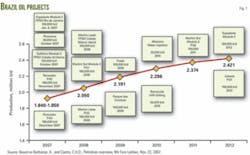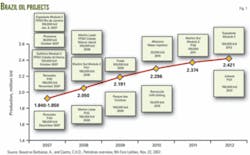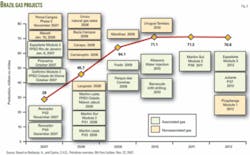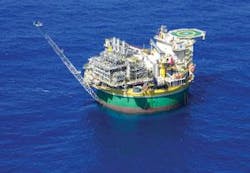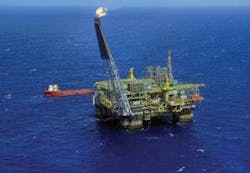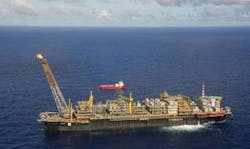Petrobras continues to add producing facilities off Brazil
Petroleo Brasileiro SA (Petrobras) in 2007 added five floating production units to its extensive operations off Brazil and plans many more during the next decade, according to company reports during the year.
In January 2007, the company started producing to the Cidade do Rio de Janeiro floating production, storage, offloading (FPSO) vessel moored in Espadarte field. In October, production started to the world’s first cylinder-shaped FPSO installed in Pirama field.
The FPSO Cidade de Vitoria went on stream in Golfinho field in November. This was followed in November and December with the start-up of the P-52 semisubmersible production unit and the P-54 FPSO in Roncador field
With this additional capacity, production in Brazil set a record of 2 million bo/d near yearend 2007.
As developments in Brazil continue, the company expects production in Brazil to reach 2.421 million bo/d in 2012 and 2,812 million bo/d in 2015 (Fig. 1). Gas production likewise is set to increase to 70.8 million cu m/ day in 2012, up from the 28 million cu m/day average in 2007 (Fig. 2).
Espadarte
The Cidade do Rio de Janeiro was the second FPSO installed in Espadarte field in the Campos basin. The FPSO has a design processing capacity of 100,000 bo/d and 2.5 million cu m/day of gas.
The 320-m long FPSO, moored in 1,350 m of water, provides storage for up to 1.6 million bbl of oil. Petrobras leases the vessel from MODEC International LCC and has tied it into five subsea production wells and four water injection wells.
Petrobras noted that the FPSO has several technological innovations aboard, among which is a new oil-pumping system developed by the Petrobras research center (Cenpes). The underwater centrifuge pumping system (S-BCSS) assists in lifting oil from the field to the platform. It is installed externally to the well, on the seafloor.
Petrobras says that the system will expedite pump maintenance and facilitate replacement of pumps. This in turn will lower operating costs, facilitate remote intervention in the connected wells, and eliminate the need for completion rigs, one of the most expensive equipment to lease in the international market, according to Petrobras.
Production from Espadarte field, discovered in 1988, started in 2000 to the FPSO Espadarte. The production also includes the eastern part of Marimba field. Petrobras said production to the FPSO Espadarte peaked in 2003 at 45,000 bo/d.
Pirama
Petrobras developed Pirama field with a cylindrical FPSO designed to process 30,000 b/d of 44° gravity light oil (Fig. 3). The field is in the Sergipe-Alagoas basin in Northeast Brazil and lies in more than 1,200-1,600 m of water.
Petrobras leases this vessel, the world’s first cylinder-shaped FPSO from Sevan Marine ASA. The vessel can store 300,000 bbl of oil and has a 3.6 million cu m/day compression capacity.
Golfinho
The FPSO Cidade de Vitoria, installed in the Espirito Santo basin Golfinho field Module 2, has a 100,000 bo/d and 3.5 million cu m/day design processing capacity.
The Golfinho field produces a 28° gravity oil and initial production to the FPSO was 20,000 bo/d from one well with production reaching 70,000 bo/d by yearend after connection of two more wells.
Petrobras expects to reach peak processing capacity in first-half 2008, when production from the Espirito Santo basin, including the previous facilities, may total 200,000 bo/d, up from 120,000 bo/d. Production of Golfinho, discovered in 2003, started with production tests in February 2006 followed by production to the FPSO Capixaba in May 2006.
The FPSO Cidade de Vitoria is in 1,386 m of water, about 50 km off the central portion of the Espirito Santo coast and connects to four oil-producing, two gas-producing, and three water-injection wells.
Oil production is offloaded to tankers, while a pipeline moves the gas ashore to the Cacimbas gas treatment unit in Linhares.
Roncador
Two addition vessels installed in the Campos basin Roncador field started processing production in November and December.
The P-52 (Fig. 4) is a semisubmersible production unit while the P-54 is an FPSO (Fig. 5). With both units online and including the FPSO Brazil installed in 2002, the processing capacity in the field is now 460,000 bo/d.
The P-52 has a designed processing capacity of 180,000 bo/d of 28° gravity oil and can compress 7.5 million cu m/day of gas. The facility has a 300,000 b/d water injection capacity.
Petrobras expects P-52 to reach the designed production capacity in second-half 2008. The vessel is in 1,800 m of water and connects to 18 producing and 11 water-injection wells. P-52 has a 125-m length, 110-m width, and 150-m height including the flare boom.
The Keppel Fels shipyard in Singapore built the hull, while the Brasfels yard in Brazil constructed the topsides and integrated the deck with the hull. Construction lasted 26 months.
The oil processed on P-52 goes to an autonomous repumping platform (PRA-1) and then is transferred to a floating production storage unit (FSO Cidade de Macae), which will also store production from four other future production platforms.
From the FSO Cidade de Macae, Petrobras transfers the oil destined to domestic consumption with offloading tankers to the São Sebastiao terminal, on the coast of Sao Paulo, while export tankers offload and transport the oil elsewhere.
A pipeline transports the gas to a distribution unit and then to the Garoupa platform from which the gas continues ashore. Petrobras expects to reach a 3.2 million cu m/day peak gas flow by yearend 2008.
The other unit added in Roncador was the P-54 FPSO.
Petrobras expects P-54 to reach its 180,000 bo/d design capacity in second-half 2008. At that time the vessel also will be processing about 1.8 million cu m/day of gas.
The vessel has 6 million cu m/day of gas compression capacity.
The P-54 is a conversion of the Barao de Maua tanker and can store 200,000 bbl of oil. As with the P-52, Petrobras says the vessel was built with the new national content requirement of 63%. Construction took 41 months with the Jurong Shipyard in Singapore converting the hull. The process, utility, and compression modules were built at Maua-Jurong shipyard in Niteroi, Brazil, and the power generation modules at Nuovo Pignone’s Porto Novo Rio yard in Caju, Brazil.
Moored in 1,400 m of water, the 337-m long vessel connects to 11 oil and gas producing wells and 6 water-injection wells.
Tankers will offload the oil from the vessel, while a pipeline will move the gas ashore. Petrobras expects a peak gas production of 1.8 million cu m/day.
2008 and beyond
Petrobras plans to deploy three new oil platforms and one gas platform off Brazil in 2008. These include:
- P-51 in Marlim Sul field, Campos basin, with a 180,000 bo/d processing capacity.
- P-53 in Marlim Leste field, Campos basin, with a 180,000 bo/d processing capacity.
- FPSO Cidade de Niteroi in Marlim Leste field, Campos basin, with a 100,000 bo/d capacity.
- FPSO Cidade de Sao Mateus in Camarupim field, Espirito Santo basin, with a designed processing capacity 10 million cu m/day of gas. Petrobras is the operator with 65%, while El Paso holds the remaining 35%.
Figs. 1 and 2 show the offshore facilities planned to be installed off Brazil during 2008-12. In addition, major projects that Petrobras lists as coming on stream off Brazil in 2013-15 include:
- Roncador P-55, Campos basin.
- Papa-Terra, Campos basin, 350 million boe potential. Interest owners are Petrobras 65% and Chevron 35%.
- Maromba, Campos basin, 140 million boe potential. Interest owners are Petrobras 65% and Chevron 35%.
- Cachalote and Balaeia Franca, Campos basin near producing Jubarte field.
- Balaeia Azul, Campos basin near producing Jubarte field.
- Caxareu; Campos basin subsalt discovery at 4,862-m depth, 30° gravity oil, in 1,011 m water depth, and 570 million bbl of in place potential, near Jubarte field.
- Pirambu; Campos basin subsalt discovery, 29° gravity oil, 1,270 m of water.
- Tupi; Santos basin subsalt carbonate discovery, 28° gravity oil, with a potential of 5-8 billion bbl of recoverable oil. Long-term production tests are scheduled for early 2010. Interest owners are Petrobras 65%, BG Group 25%, and Petrogal-Galp Energia 10%.
